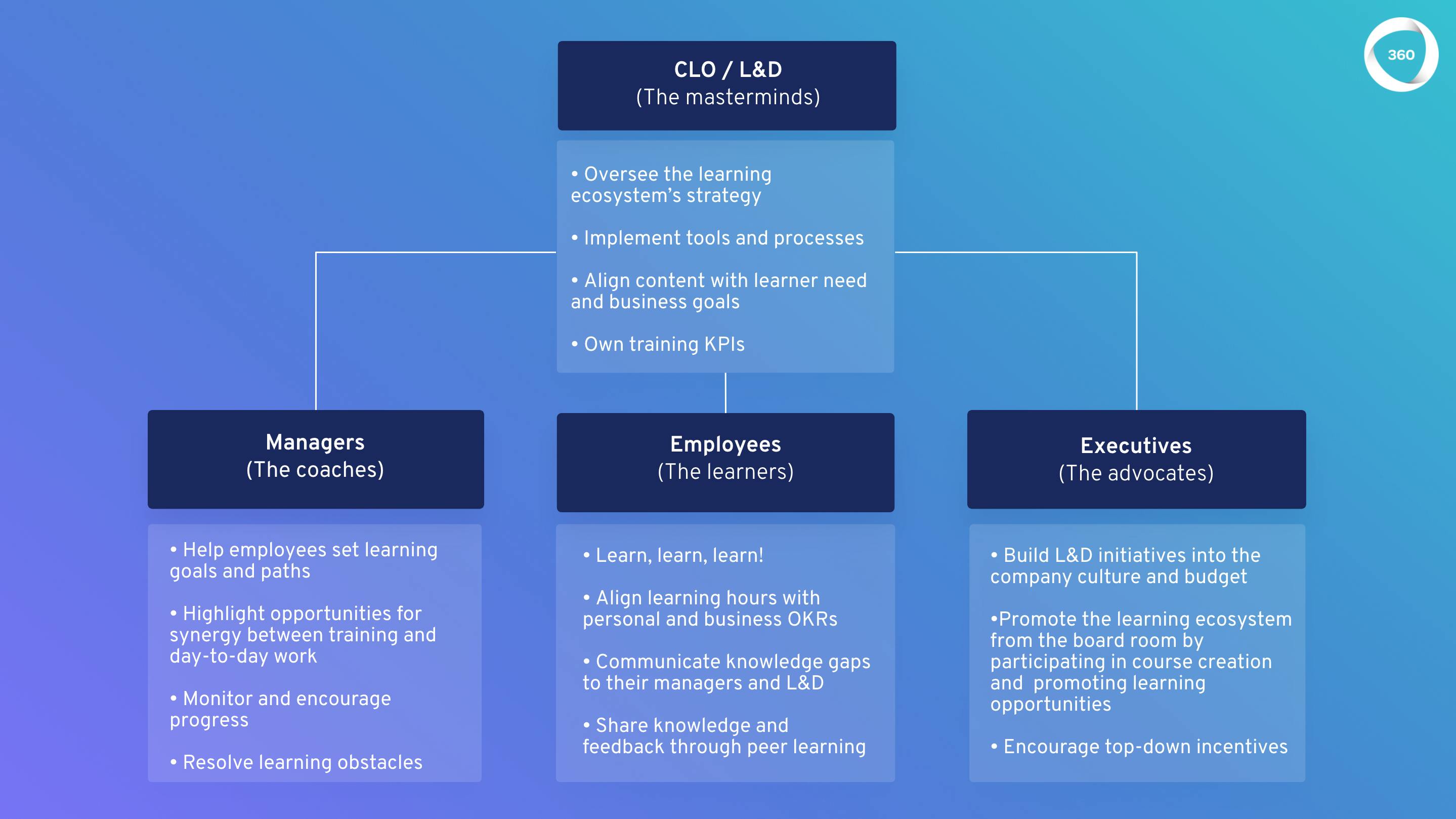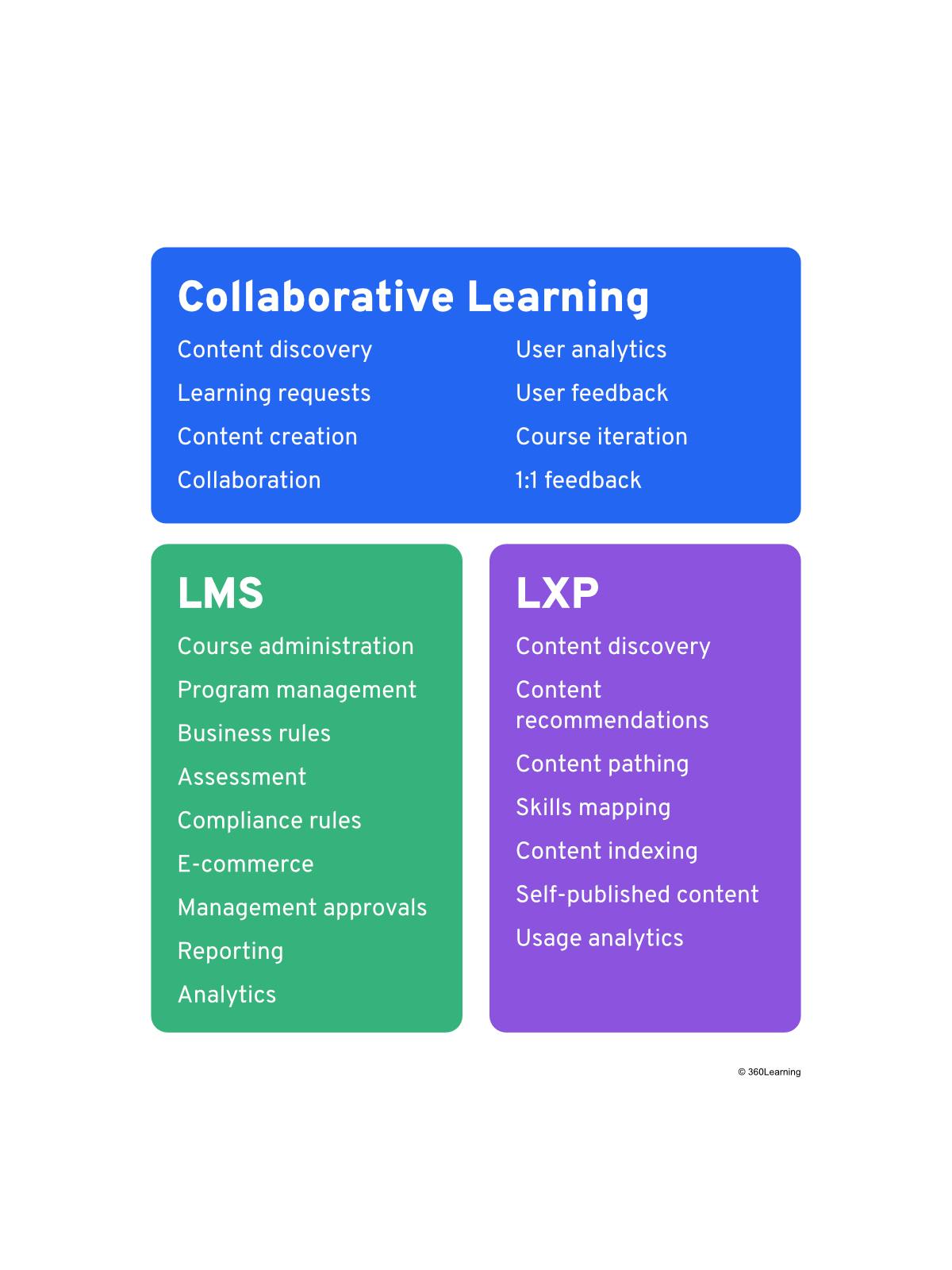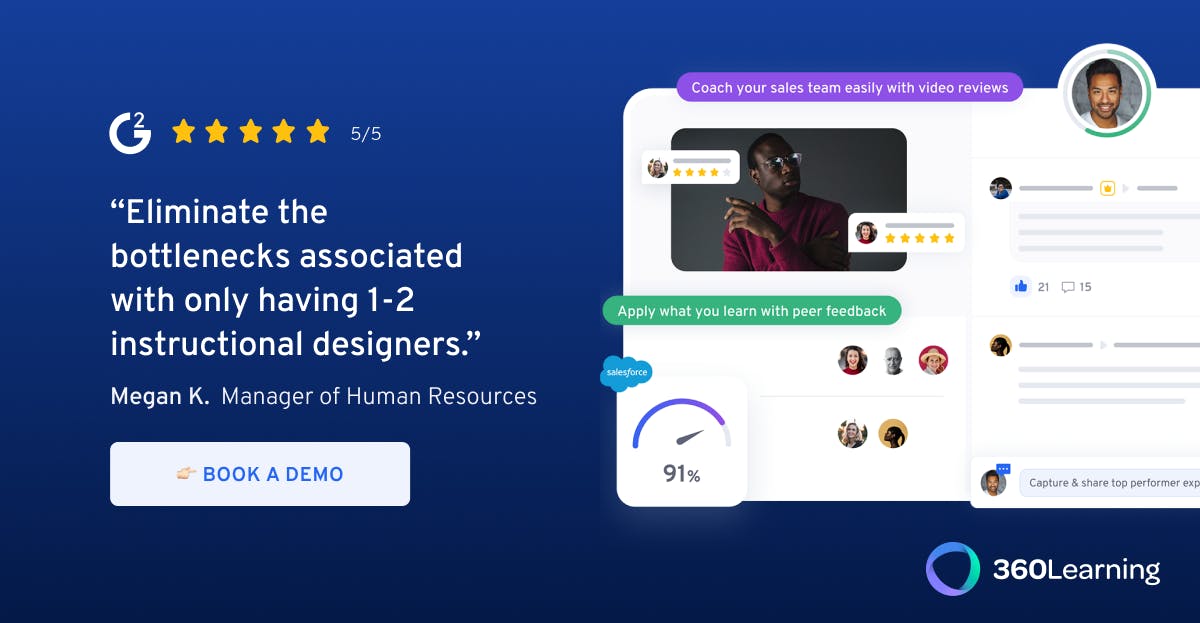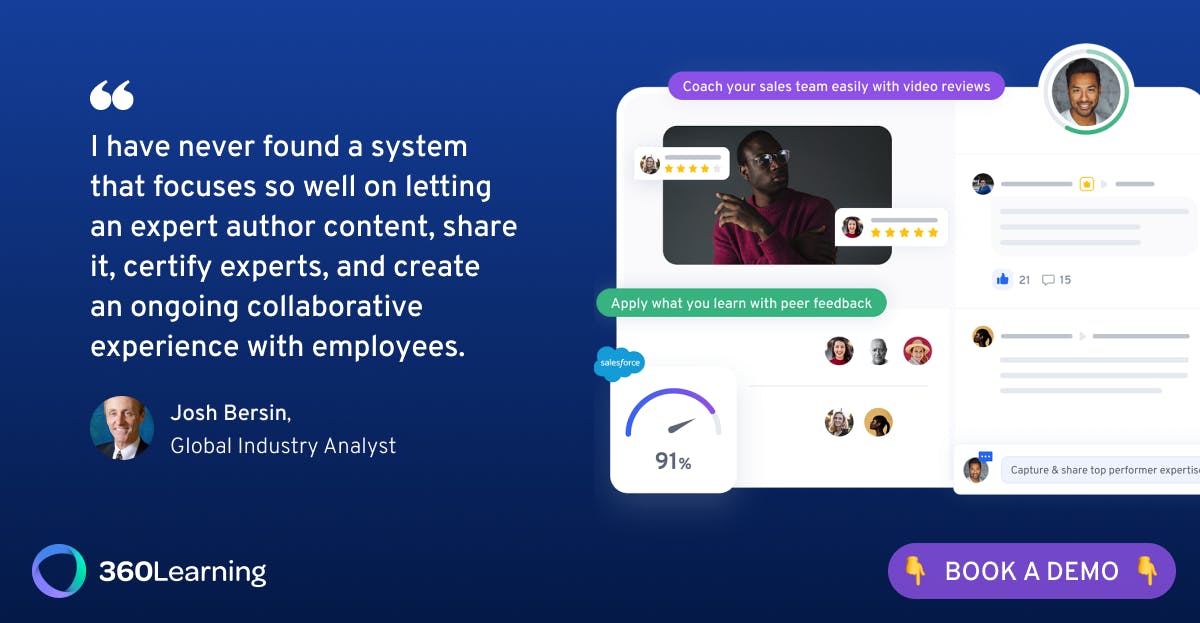Sound the alarm: We’ve got a buzzword on our hands.
The term “learning ecosystem” has been bandied around for the past few years, and we wanted to see how it would hold up under closer inspection. What does the term actually mean? Is it an apt metaphor for workplace L&D? How do you achieve a learning ecosystem?
If you don’t know, an ecosystem is a term biologists use to describes the complex, interconnected relationships between an environment (living and nonliving) and all its inhabitants (everything from the largest animals down to the smallest micro-bacteria).
In the context of L&D, learning ecosystem gives us a way to talk about your organization’s learning infrastructure: all the people, systems, tools, and technology that enable learning at your organization.
When we superimpose this image onto L&D, we get a compelling vision for workplace learning. In my mind, it conjures an image of L&D that’s
- decentralized — an ecosystem is a web of relationships, it has no one single authority;
- peer-driven — an ecosystem depends on input (and output) from all elements, living and nonliving; and
- agile — a natural ecosystem can resiliently evolve and find balance through change.
While the term sparks the imagination, it doesn’t offer much actionable information to help you bring a learning ecosystem to life. In fact, learning ecosystem makes this kind of healthy learning environment sound organic, like it might just emerge naturally and achieve balance on its own. But as anyone who’s worked in L&D knows, it’s not that simple.
Creating harmony and balance in workplace learning takes an organized, concerted effort. In order to achieve the learning ecosystem vision, you must build, implement, and maintain it. Here, we’ll help you make the metaphorical actionable with three steps to create a healthy learning ecosystem in your business.
1. Assign roles to the people in your learning ecosystem
Assign roles to the people in your learning system, because unlike animals in a natural ecosystem, they don’t innately know how to maintain the ecosystem. If you don’t, your decentralized learning ecosystem will quickly devolve into a decentralized disorganization.

CLO and other L&D team members facilitate the learning ecosystem
L&D: you are the masterminds (and active commanders) behind a healthy learning ecosystem.
You oversee the entire learning ecosystem’s strategy, implement tools and processes, engage team members from every department, align learning content with business goals and learner needs, and own training KPIs.
Employees learn and pass feedback up the chain
The major responsibility of employees in a learning ecosystem is to learn. But they can’t just aimlessly surf through learning content; they must pursue measurable learning goals that align with personal and business OKRs. And they must pay attention to gaps in their learning content and communicate them to managers and L&D — this kind of communication helps L&D perpetually assess and fulfill training needs.
Managers coach their employee-learners
When it comes to learning, think of managers as coaches: They should be on the sidelines, ready to motivate and support their employees throughout learning. Specifically, they should:
- help employees set learning goals,
- suggest learning paths,
- highlight learning opportunities that compliment day-to-day work
- monitor and encourage progress, and
- step in to resolve obstacles as needed.
C-Level Executives Advocate for the learning ecosystem
For any learning culture to have legs, including a learning ecosystem, it must have executive-level support. Executives have the ability to build learning into the foundation of a company’s culture (and, not for nothing, budget), so buy-in is essential.
But beyond buy-in, executives have an opportunity to take learning to the next level by becoming learning advocates. Specifically, they have an opportunity to bolster engagement by promoting L&D, creating executive course content themselves, and encouraging top-down incentives for learning.
Assign roles to the people in your learning system, because unlike animals in a natural ecosystem, they don’t innately know how to maintain the ecosystem.
2. Choose a learning tool that facilitates peer-to-peer knowledge flow
If you want to create a healthy learning ecosystem, you need to facilitate a continuous, autonomous flow of learning. Otherwise, you won’t have a learning ecosystem at all, but a regular, L&D-dependent structure. How do you achieve that flow of learning? Peer-driven tools, which give employees the power to learn from one another.
When it comes to choosing a tool for your learning ecosystem, the first-order priority is to choose a self-serve platform. Your options include LMSs, LXPs, Talent Suites, and Learning Platforms. All of them allow employees to log in and learn on their own time instead of solely relying on L&D to administer training.
If your goal is a learning ecosystem, though, you need to offer more than a catalog of self-serve courses to engage learners and avoid a learning infrastructure that’s too dependent on L&D.
“Employees use social media and search in their spare time to satisfy their curiosity, right when they need it,” says Elisabetta Galli, Global Head of Knowledge, Development, and Talent Management at Banco Santander. “It should be exactly the same at work ... This is our vision: to create a learning-in-the-flow-of-work ecosystem and become a learning organization, whose workforce is upskilled in real time.”
How do you achieve learning in the flow of work? By giving your employees tools to create, share, and iterate learning content directly (and in turn, freeing L&D to focus on higher-level strategy, not just content creation). In other words, by tapping into Collaborative Learning.
Think of it this way: In a natural ecosystem, energy flows in a seamless cycle between the sun, water, plants, animals, etc.
Similarly, in a learning ecosystem, learning content flows seamlessly between team members at every level of the organization. A Collaborative Learning platform makes that seamless flow possible.
Even without Collaborative Learning, 55% of employees learn new skills by asking coworkers before turning to a traditional LMS or Google. Creating a seamless flow of learning means embracing ways to make natural peer exchange more powerful, not fighting against it.
Compared to a traditional LMS and LXP, Collaborative Learning provides more opportunity to create and request new content, provide feedback, and spark 1:1 conversations between the learner and the content creator. Here’s a more detailed breakdown of how they stack up:

When employees can create, share, and iterate learning content autonomously, you can cut out the go-between (L&D) and avoid needless back-and-forth and bottlenecking. Plus, when subject-matter experts are empowered to easily share their institutional knowledge in a new course, it’s easier to maintain a library of relevant, up-to-date learning content.
In other words, Collaborative Learning reroutes the flow of learning to take pressure off instructional designers, many of whom don’t have the bandwidth to keep up with content requests.
With the bandwidth they win back, L&D departments can focus on facilitating this new knowledge flow. So instead of scrambling to keep pace, they help employees learn from one another directly and maintain a healthy, sustainable learning ecosystem.
Related: The L&D Case for Peer Training: 3 Unignorable Reasons to Make the Switch
3. Align and measure your learning ecosystem against business goals
Natural ecosystems have only one imperative: biological survival. Learning ecosystems don’t fight biological survival, but they do need to maintain ROI and align with business goals in order to stay viable.
Seventy-nine percent of CEOs believe skill gaps could threaten the health of their organizations. The promise to close those skills gaps and protect the health of the organization is what funds L&D. So, as you design and implement your learning ecosystem, be sure to understand how you’ll justify the ROI of L&D in clear, measurable ways.
Fortunately, there are a number of KPIs you can use to paint a well-rounded picture of the impact of time and dollars spent learning:
- Assessments, such as quizzes at the end of a course, indicate skill gain. Is the employee walking away from training with a new, relevant skill?
- Micro-surveys and feedback, either during training or in managers’ one-on-ones, gauge employee satisfaction. Are employees interested and engaged in learning content? What’s missing?
- Employee performance, measured by team leads while on the job, can indicate whether training leads to productivity and efficiency. Put simply, does training make employees better at their jobs?
- Bottom line indicators, the business benefit of training, communicates the value of training to executives. Is our learning approach a viable way to keep the business competitive?

Business needs shift quickly and sometimes unexpectedly (case in point: 2020). Keeping a close eye on KPIs is the best way for you to ensure that workplace learning stays relevant, and even drives the evolution of your business.
KPIs give L&D and the business at large a common language, helping both stay agile and adaptive through change. By using them to (re)align L&D to businesses goals, you can achieve the agile, adaptive promise of learning ecosystems.
Related: 3 Data-Based Ways To Prove Training ROI (+ Free Training ROI Calculator)
The verdict: Are learning ecosystems a viable approach for L&D?
Long story short: yes, learning ecosystems can be a viable framework to think about L&D.
L&D is in the middle of a sizable shift, according to industry analyst and L&D expert Josh Bersin. “A new paradigm has arrived,” he says. “One I call ‘Learning in the Flow of Work.’” What he describes is akin to a learning ecosystem, where employees autonomously integrate a continuous stream of learning content into their work.
With these actionable steps, you begin to translate nebulous ideas like “learning ecosystem” and “learning in the flow of work” into real-world L&D frameworks. Specifically, frameworks that are decentralized, peer-driven, and agile — exactly what’s needed to keep up with today’s learning needs.
Want to learn more about turning metaphor into concrete, actionable plans? Check out our tips to help you secure your 2021 training budget.




